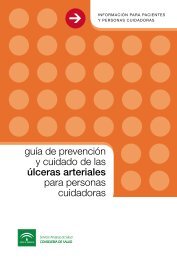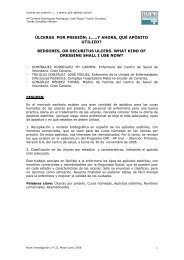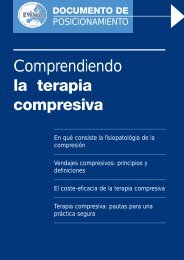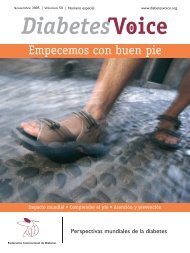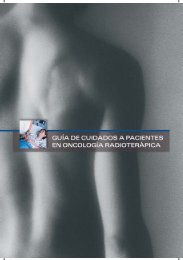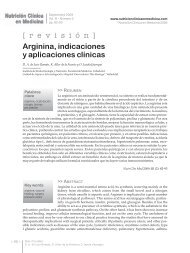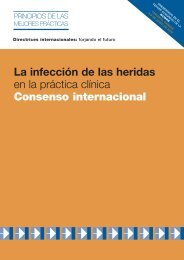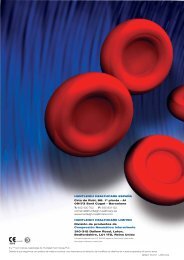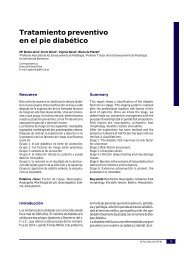Descargar - Úlceras.net
Descargar - Úlceras.net
Descargar - Úlceras.net
- No tags were found...
Create successful ePaper yourself
Turn your PDF publications into a flip-book with our unique Google optimized e-Paper software.
126 ■ PIE DIABÉTICOan ulcer (23). Diabetic patients with footulcers have an increase of 2.4 times in theoverall mortality risk in comparison to thosewithout foot ulcers (21).Treatment and prevention of diabetic footulcers should be based on preventing progressionof neuropathy through rigorousmetabolic control, addressing peripheral arterialdisease in a precocious fase, appropriatewound dressing and thorough debridement,pressure relief, infection control and healtheducation in foot care and footwear (20, 22).PHYSIOLOGIC EFFECTSOF HIPERBARIC OXYGEN THERAPYWound-healing impairment in the diabeticfoot results from an imbalance between oxygensupply, due to diminished local blood flowcaused by micro and macrovascular arterialdisease, autonomic neuropathy, tissue oedema,compromised erythrocyte deformabilityand increased glycated haemoglobin with consequentabnormal oxygen delivery, but alsofrom an increased tissue oxygen demand. Inan infected ulcer, oxygen needs can be as highas 20 times of normal tissue demands (23).Both of these mechanisms result in a loweroxygen pressure in the tissue surrounding thewound, which results in compromised healing.Beneficial effects of HBOT with applicabilityin the Diabetic Foot setting are:Correction of tissue Hypoxia – HyperbaricOxygen Therapy (HBOT) corrects woundhypoxia by increasing the total blood content ofoxygen, principally the plasma dissolved fractionof Oxygen. Physiologic vasoconstriction occursin hyperoxic tissues directing blood to hypoxicareas, thus accounting for the redistribution ofoxygen to these tissues. These mechanisms areresponsible for the increase of transcutaneousoxygen pressure (TcPO 2) measured in the tissuesurrounding the wound. In normal, nonhypoxictissue, TcPO 2is approximately 40mmHg. Under HBOT, the partial pressure ofoxygen in the hypoxic wounds may increasefrom a basal 10-20 mmHg to 200 mmHg (24).In a prospective randomized trial, it wasdemonstrated that the TcPO 2measured in thetissue around the wound increased from 22 to454 mmHg, approximately, at the end of thefirst HBOT session (25).Hemorrheiologic effect – Red blood celldeformability is improved which also amelioratesmicrocirculation (24, 26, 27, 28).Oedema reduction-Vasoconstriction se -condary to the increase in arterial PaO 2decreases intracapillary pressure, leading toreduction of vasogenic tissue edema and interstitialpressure, which contribute to a better tissueoxygenation (20, 23, 24, 26, 27, 29).Wound healing-The increased O 2concentrationassociated with HBOT stimulates fibroblasticcellular division, collagen synthesis andextracellular transportation, and promotes inincrease in extracellular matrix protein production,increasing collagen deposition in the connectivetissue matrix. HBOT also increases theenzymatic activity of the lisin-oxydase that promotescrossed-linkage collagen molecules,therefore reinforcing the structural resistanceof the connective tissue matrix. This processwill indirectly promote angiogenesis and epithelizationof the wounds, by providing them anadequate collagen matrix for structural support(18, 20, 23-29).Angiogenesis – Oxygen (O 2) gradientsthroughout the ulcer resulting from HBOTpromote endothelial growth factor productionwhich in turn leads to capillary growththus stimulating directly angiogenesis (18, 20,23-29).Indirect antimicrobial effects– Increased leukocyte phagocytic activity-Neutrophil phagocytic capacity is null whenlocal O2 tension is less than 28 mmHg.Tissue O 2tension elevation has beneficialeffect on leukodiapedesis and alsoneutrophil phagocytic activity (18, 20, 21,23-29).– Reinforcement of leukocyte toxic effect onbacteria-Hyperoxia is responsible forincreasing superoxide radical productionby leucocytes, which has a bacterial lyticeffect inside phagossomes (18, 20, 21,23-29).





